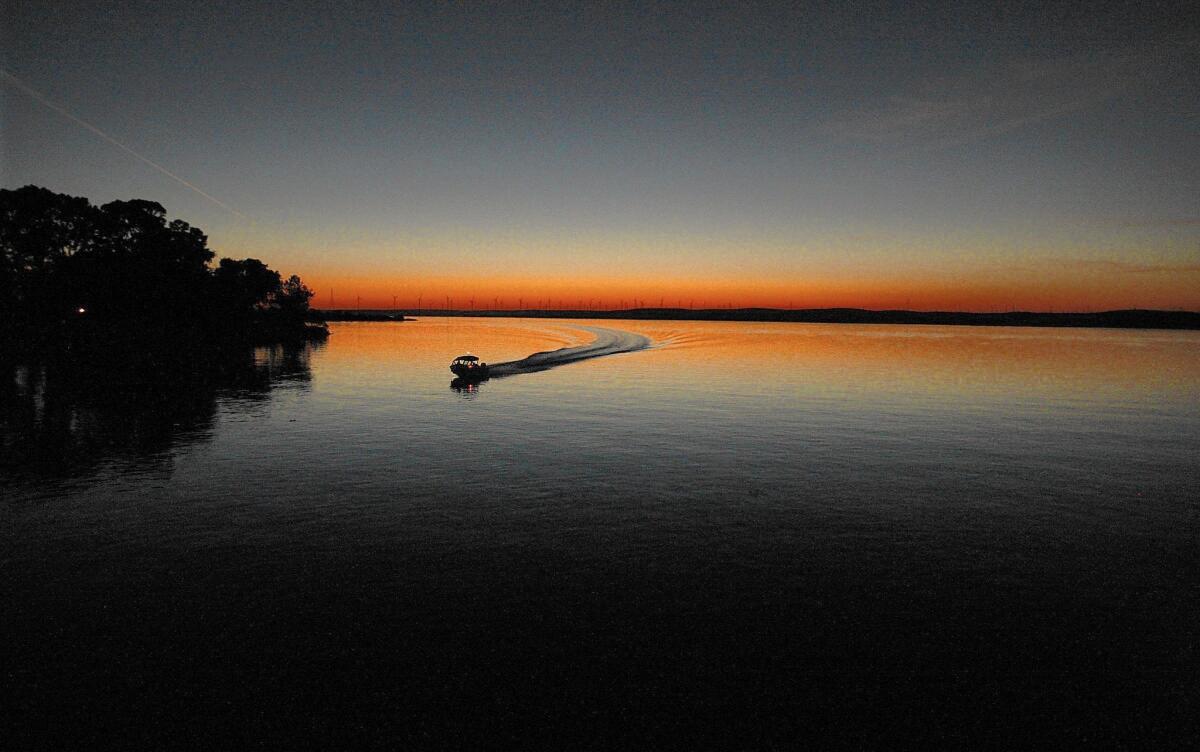$25-billion Sacramento-San Joaquin delta tunnel project reexamined

- Share via
Gov. Jerry Brown’s administration is overhauling its proposal for a controversial tunnel project in the Sacramento-San Joaquin delta in the wake of doubts about whether water exporters can meet stringent federal conditions for operating the system over a 50-year period.
The $25-billion Bay Delta Conservation Plan is intended to lessen the environmental harm of delta water exports by restoring about 100,000 acres of delta fish and wildlife habitat and building two massive tunnels under the delta that would carry Sacramento River water from a new diversion point to existing pumping facilities that fill southbound aqueducts.
A major goal of the plan is to gain a 50-year environmental permit for delta exports that would ease the endangered species restrictions that have cut delta deliveries to San Joaquin Valley growers and the urban Southland.
But state water officials have concluded that the federal requirements for such long-term approvals are too onerous for the water exporters to meet.
“We are considering a lot of different ways of proceeding with the program,” said Mark Cowin, director of the state Department of Water Resources. He declined to provide details.
Sources familiar with the state discussions said that it is likely the department will separate the habitat restoration component from the tunnel proposal and pursue shorter-term operating permits for the new diversion facilities and existing pumping operations. Although the Bay Delta plan included restoration money, it is unclear how the separate restoration effort would be funded or carried out.
While the changes would not affect construction of the tunnels, they have raised concerns that the restoration work could fall by the wayside. And the revisions, expected to be released in coming weeks, could also make the project less attractive to the urban water and agricultural irrigation districts that have promised to pick up the roughly $15-billion construction tab.
Cowin said that while changes are still being worked out, the state will move ahead with plans to both build the tunnels and restore delta habitat.
“I’m as committed to improving delta conveyance and making the other necessary improvements to the delta … as I’ve ever been,” Cowin said.
The tunnel proposal, in the planning stages for nearly nine years, predates Brown’s administration. But it is a variation of a doomed peripheral canal project Brown supported in his second term as governor. Voters in 1982 killed that proposal, which called for the construction of a large canal to carry Sacramento River water around the delta to export pumps.
Proponents say the new diversion point and tunnels would reduce harmful environmental impacts of the pumping operations, which draw directly from the south delta, killing delta smelt and migrating salmon.
The pumps are so powerful that they reverse the direction of delta waterways and have profoundly altered natural hydrologic cycles.
Although the current tunnel project was not conceived as drought protection, backers say easing pumping restrictions would allow more water to be sent south of the delta in wet years, boosting drought reserves in the Southland and San Joaquin Valley.
The plan revisions would represent more than just a bureaucratic change. The agricultural and urban water districts that are the major drivers of the long-planned project were betting that a 50-year permit would stabilize delta deliveries that have been restricted by increasingly stringent protections for endangered fish.
Reverting to shorter-term approvals would leave future water deliveries vulnerable to cuts associated with a change in permit conditions. And that raises questions of whether the project is still worth the money to the districts that have promised to pay for the tunnels.
“We don’t really know what the permitting will be 10 years from now, 15 years from now,” said Jeffrey Kightlinger, general manager of the Metropolitan Water District of Southern California, which would cover a portion of the tunnels’ cost. “That’s the challenge in making sure it’s a sound investment. Does it pencil out and still make sense?”
On the other hand, Kightlinger said that if the water exporters don’t have to plan for a half century of evolving delta conditions, “it makes an easier path to permitting” and construction, which is expected to take seven years.
“I think there are pros and cons” to what the state is considering, he said.
Federal fishery agencies have not been persuaded that the habitat improvements will significantly benefit imperiled fish. They also are demanding higher outflows of fresh water from the delta to the ocean to help restore natural hydrologic cycles with which native fish evolved.
To obtain the 50-year permit, the state and water exporters would have to commit to maintaining those outflows under a variety of conditions over half a century. They could do that by either paying upstream diverters to release water that would flow through the delta or by reducing water exports. That would cost more money and water than they can commit to now.
“If we jettison the 50-year permit term,” Cowin said, “we may wind up having to put those kinds of assets on the table over time. But we don’t have to do it up front.”
Supported by the largest urban water and irrigation districts in the state, the tunnel project is opposed by delta residents and many environmentalists who argue it will lead to greater exports at the expense of the delta environment.
Separating plans for the habitat work from the tunnel construction only adds to their concerns. “Once again, the promise of mitigation and restoration in the delta is taking a back seat,” said Patricia Schifferle, director of Pacific Advocates, an environmental group. “One cannot trust that the mitigation will actually get done.”
More to Read
Sign up for Essential California
The most important California stories and recommendations in your inbox every morning.
You may occasionally receive promotional content from the Los Angeles Times.











